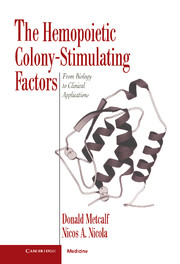Book contents
- Frontmatter
- Contents
- Preface
- 1 Historical introduction
- 2 General introduction to hemopoiesis
- 3 Key techniques in analyzing hemopoiesis
- 4 Biochemistry of the colony-stimulating factors
- 5 Biochemistry of the colony-stimulating factor receptors
- 6 Molecular genetics of the colony-stimulating factors and their receptors
- 7 Biological actions of the colony-stimulating factors in vitro
- 8 The biology of colony-stimulating factor production, degradation, and clearance
- 9 Actions of the colony-stimulating factors in vivo
- 10 Role of the colony-stimulating factors in basal hemopoiesis
- 11 Actions of the colony-stimulating factors in resistance to infections
- 12 Role of the colony-stimulating factors in other disease states
- 13 The colony-stimulating factors and myeloid leukemia
- 14 Clinical uses of the colony-stimulating factors
- 15 Conclusions
- References
- Index
5 - Biochemistry of the colony-stimulating factor receptors
Published online by Cambridge University Press: 04 August 2010
- Frontmatter
- Contents
- Preface
- 1 Historical introduction
- 2 General introduction to hemopoiesis
- 3 Key techniques in analyzing hemopoiesis
- 4 Biochemistry of the colony-stimulating factors
- 5 Biochemistry of the colony-stimulating factor receptors
- 6 Molecular genetics of the colony-stimulating factors and their receptors
- 7 Biological actions of the colony-stimulating factors in vitro
- 8 The biology of colony-stimulating factor production, degradation, and clearance
- 9 Actions of the colony-stimulating factors in vivo
- 10 Role of the colony-stimulating factors in basal hemopoiesis
- 11 Actions of the colony-stimulating factors in resistance to infections
- 12 Role of the colony-stimulating factors in other disease states
- 13 The colony-stimulating factors and myeloid leukemia
- 14 Clinical uses of the colony-stimulating factors
- 15 Conclusions
- References
- Index
Summary
The receptors for the colony-stimulating factors are responsible for detecting and responding to the presence of CSFs in the medium and initiating an appropriate biological response. Initially there appeared to be a great deal of complexity in the structure of CSF receptors. High- and lowaffinity forms, cross-reactive and non-cross-reactive forms, and different molecular sizes for each type of CSF receptor have been described. With the molecular cloning of CSF receptor subunits (Figure 5.1), the situation has been considerably clarified, and a great deal of uniformity has emerged. The M-CSF receptor is a classical growth factor receptor of the tyrosine Kinase type, while the other CSF receptors all belong to a superfamily of hemopoietin receptors (Table 5.1). They each function by forming homo- or heterodimeric receptor complexes that result in the activation of cytoplasmic tyrosine kinases and downstream signaling events. In this chapter the structure and function of CSF receptors will be reviewed with an emphasis on their common structural organization and signaling mechanisms.
M-CSF receptor (c-fms)
The recognition that the feline retroviral oncogene (v-fms) encoded a cellsurface receptor that could bind M-CSF (Sherr et al., 1985) allowed the first molecular definition of a CSF receptor. The cellular homologue of the viral oncogene (c-fms) is a single-chain type III membrane glycoprotein with a single transmembrane domain of 25 amino acids, an N-terminal extracellular domain of 512 amino acids (including the leader sequence), and a C-terminal intracellular domain of 435 amino acids (Coussens et al., 1986; Rothwell and Rohrschneider, 1987).
- Type
- Chapter
- Information
- The Hemopoietic Colony-stimulating FactorsFrom Biology to Clinical Applications, pp. 65 - 90Publisher: Cambridge University PressPrint publication year: 1995



